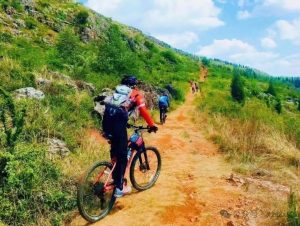Riding on the Tombs of Emperor Suzong of the Tang Dynasty
Jianling is the tomb of Tang Suzong Li Heng, located at the southern foot of Wujiang Mountain, 15 kilometers northeast of Liquan County, Xianyang City. As the mountain is a tomb, there is Li Shimin’s Zhaoling to the east and Wu Zetian’s Qianling to the west. Li Heng (711-762) was the third son of Emperor Xuanzong of Tang. After the Maweiyi Rebellion, Emperor Xuanzong fled to the west, and Li Heng succeeded him to the throne. He reigned for 6 years before dying in a palace coup at the age of 51. The Tang Jianling Mausoleum is the most preserved, complete, and finely carved among the eighteen Tang tombs in Guanzhong. It is currently a national key cultural relic protection unit and is free to visit..

For the first time cycling after the Spring Festival in 2024, I invited my cycling friends “Huyou Ge” and “Le Xiaoyao” to ride Tang Jianling together. The Wujiang Mountain in Jianling Street, Zhaoling Town, Liquan County, where Jianling is located, is about 90 kilometers away from Yanliang District, Xi’an City, with an altitude of 981 meters..

Starting from Yanliang District, Xi’an City, ride west along Guanzhong Ring Road S107, pass through Yanxia Town, and then head north to Caiyuan Village in Zhaoling Town, passing through the high-quality pomegranate industry base..

From Caiyuan Village, head west along Yanzhao Road to Zhaojia Village, then turn north from Zhaojia Village and start climbing all the way to the entrance of the road in Qianshan Village..

There is a landscape stone of the “Wujiang Mountain” demonstration area standing next to the door..

Along the wide asphalt road, head north up the mountain, then turn around a large ravine from Zhaojiashan Village and onto Shimaling Village (see the road map at the end of the article). There is a national key cultural relic protection monument called “Jianling” standing on the roadside at the entrance of the village..

There is a Tang Jianling Cultural Management Office set up at the village entrance, and the road leading to Jianling is on the left side of the cultural management office..

There are two provincial-level key cultural relics protection monuments standing on the ground opposite the Cultural Management Office, which were erected by the government of Liquan County in 1981 and 1984, respectively..

The inscription on the back of the cultural heritage monument bears significant historical characteristics..

The field behind the monument is littered with the remains of a “ornamental column”..

There are still several stone carvings lying next to the document management office, and their original appearance can no longer be seen..

Following the asphalt road uphill to the north, I saw a row of stone figures and horses standing on the right side of the field, so I stopped to visit. The first thing I saw was a base for installing ornamental column watch. It is estimated that the ornamental column watch I saw just now should have been installed here..

Next is the winged horse battle horse, some of which have been damaged..

Looking back, there is a neatly arranged row of stone figures and horses by the field, and a corresponding row of stone figures and horses is also arranged opposite the ditch on the right. The huge ravine in the middle should be the original Shintoism. After more than 1200 years of flood erosion, the original Shintoism no longer exists and has gradually become a large ravine. Fortunately, stone figures and horses still stand on both sides of the ravine, facing each other across the ravine..


The stone carvings of generals located on the west side of Shinto..

A stone carving of a warrior with a missing head.

The civilian stone carvings on the east side of Shinto. These stone figures are all between 2.5-2.7 meters tall and 0.7-0.9 meters wide, with both sides facing east and west. Civil officials wear a large crown on their head, a scarf under the crown, and a wide sleeved robe with a leather belt around their waist. They wear high head shoes with their feet on. Under their back belt, there are double pendants and large ribbons, with side ribbons made up of beads on each side. They hold them on their chests with both hands. The general wears a high crown on his head, a wide sleeved robe, shoulder straps, and a crotch. He leans on seven swords with both hands, with the sword tassels wrapped around the hilt and his feet in boots..

After cycling along the Baiyou Road to the highest point of “Lingtou”, follow a dirt road up the mountain and pass through the south of Tangling.














